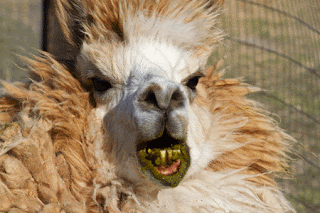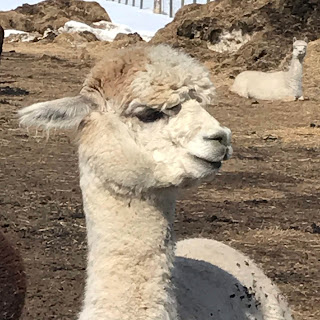 |
| Even though her ears are back, she is relaxed and looking around, not angry or threatened |
Ears back: While this can mean an alpaca is frightened or angry, most of the time they are in a relaxed. Unlike a horse or dog that many of us are familiar with indicating you should back away from the animal, more often than not the alpaca is just repositioning its ears to hear. They are a preyed upon animal, so they always want to be aware no one is "sneaking up" on them.
Spitting: The most popular association when people hear the word alpaca is spitting. Just like every dog can bite, every alpaca can spit. However, if they are well socialized to people and their surroundings, chances are you will not be directly spit at by an alpaca. I have a good record so far of 15 years and still have not been targeted. However, people can be spit in when feeding pellets or treats. Often the unwitting are caught in the crossfire of one or two alpacas trying to push off the others for food.
There are two types of spit: A head pointed up or out and air spitting as a warning. A green bile / grass / hay loogie is the follow through often after the warning. Steer clear of both.
With the green spitting, this leads to the "bubba lip" of an alpaca - a highly unattractive 15-20 minutes of the alpaca's life while recovering from spitting and/ or fighting. The bile tastes horrible in their mouth and they may try to nibble hay or grass to clean the pallet, but to no avail. They just have to wait it out until the nasty taste is gone.
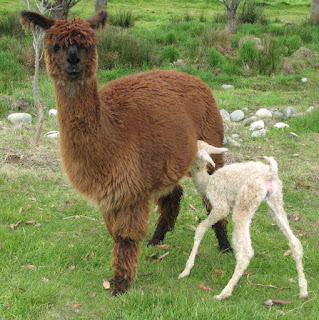 |
| A new cria nursing from its mother |
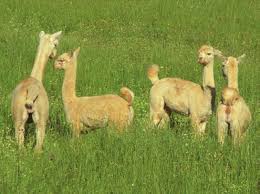 |
| This younger alpaca has its tail up in submission |
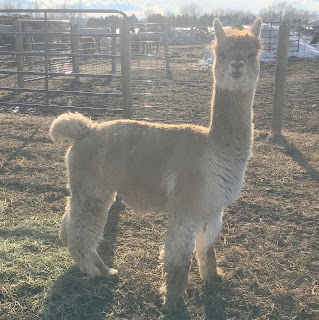 |
| Cowboy with his tail up making himself look larger |
Spit lips showing the teeth: Too often, the funny pictures of alpacas with buck teeth mean the owner has not taken care of this alpaca. Alpaca teeth continuously grow and if they are not lined up with the pallet, they will jut out. (See alpaca teeth article ) This can be remedied / corrected by trimming the teeth to line back up with the pallet over time. However, if you see teeth that are proper but showing, they are smelling you with their olfactories. Olfaction has many purposes, such as the detection of hazards, pheromones, and food. It integrates with other senses to form the sense of flavor. They are sizing up who you are and what you have.
 |
| Fran splits her upper lift to smell what I have in my hand |
Warning Whistle: Alpacas make a high pitched sound if they are scared and/ or perceive danger. This alerts the rest of the herd, including llamas, guard dogs and anyone else around that something is not right. A full repositioning of the herd happened once when a herd of elk were crossing through our pasture. The alpacas get into a circle with the babies in the middle, llamas form a line between the alpacas and threat and the livestock guard dogs are in front as the first line of defensive. This could be from a mountain or elk walking by to a neighbor dog or skunk. If they do not like it, they will let out the warning call. Even a ground squirrel giving the stink eye could evoke this warning call.
Humming: Another more common sound is a hum. They will hum in the barn, in pens, in the pasture when they are calm and slightly more when they are annoyed / distressed. This recording is from 5 ladies we put in a next door pen to give medicine and they were waiting at the gate to be let back into the main pasture - slightly annoyed but not distressed.
A new mother will hum and click constantly to its baby for the first week or two of its life. This lets the baby recognize its mother's voice in a sea of hundreds of alpaca legs in the pasture.
Clicking: I hear this most often when our boys are on opposites of the fence - friends or foe - posturing to each other. Or, someone is standing proudly on a manure / hay / snow pile showing off to the other lowly alpacas / llamas. This usually evokes a game of king of the hill which is always fun to watch.
Pregnancy testing: To test if a female is pregnant, we bring a male back in with a female 4+ days after she has been bred. If she is pregnant, she often spits and tries to get away. If she is unsure or not pregnant and willing to breed, the female may start sucking her teeth, have a quick blink of their eyes which become glazed over, and then sit down. This means she is willing to breed and receptive hormonally to the male.
More humming: When alpacas are breeding, the male hums a song to the female. Each has its own song. This is essentially a longer, more enthusiastic version of the hum and some are quite creative in their vocals.
This covers the basics of what you might see on a walk or two through a herd of alpacas.
Support Alpacas of Montana by sharing our articles and shopping our Alpaca Fleece products!
Join the alpaca revolution! Alpaca is a sustainable alternative that is not only good for the earth, but for all of us. Alpaca wool is stronger, softer, more eco-friendly, and offers 85% greater wicking capability than merino wool. It is also hypoallergenic! Learn more about the benefits of alpaca in our Alpaca vs. Wool blog posts, shop our collections and follow us on social media!

